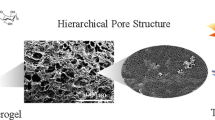Abstract
Cellulose diacetate (CDA) based aerogels for thermal insulation were prepared by CDA cross-linked with 2, 4-toluene diisocyanate (TDI) in acetone solvent. The relationship between structure and thermal conductivity of CDA-based aerogels with various reactant ratios (CDA/TDI) was studied. The obtained results show that the increase of reactants causes higher bulk density and smaller porosity of as-prepared aerogels, while its specific surface area decreases with CDA content increasing. Thermal conductivity increases with CDA content increasing, and the minimal value is 0.0313 W m−1 K−1 comparably to that of polyimide aerogel at the same environmental conditions. Meanwhile, the radiant thermal conductivities of CDA-based aerogels were calculated in the range of 0.0021–0.0054 W m−1 K−1 superior to other cellulose aerogels using wafer method. Moreover, the analyses for thermal conductivity distributions of above aerogels suggest that the solid thermal conductivity proportion increases with reactant content increasing, the gaseous one falls down, and the radiant one changes hardly.






Similar content being viewed by others
References
Cervin NT, Aulin C, Larsson PT, Wågberg L (2012) Ultra porous nanocellulose aerogels as separation medium for mixtures of oil/water liquids. Cellulose 19:401–410
Feng JZ, Wang X, Jiang YG, Du DX, Feng J (2016) Study on thermal conductivities of aromatic polyimide aerogels. ACS Appl Mater Interfaces 8:12992–12996
Han Y, Zhang X, Wu X, Lu C (2015) Flame retardant, heat insulating cellulose aerogels from waste cotton fabrics by in situ formation of magnesium hydroxide nanoparticles in cellulose gel nanostructures. ACS Sustain Chem Eng 3:1853–1859
Jiménez-Saelices C, Seantier B, Grohens Y, Capron I (2018) Thermal superinsulating materials made from nanofibrillated cellulose-stabilized pickering emulsions. ACS Appl Mater Interfaces 10:16193–16202
Kettunen M, Silvennoinen RJ, Houbenov N, Nykänen A, Ruokolainen J, Sainio J, Pore V, Kemell M, Ankerfors M, Lindström T, Ritala M, Ras RHA, Ikkala O (2011) Photoswitchable superabsorbency based on nanocellulose aerogels. Adv Funct Mater 21:510–517
Kobayashi Y, Saito T, Isogai A (2014) Aerogels with 3D ordered nanofiber skeletons of liquid-crystalline nanocellulose derivatives as tough and transparent insulators. Angew Chem 53:10394–10397
Lin RJ, Li A, Lu LB, Cao Y (2015) Preparation of bulk sodium carboxymethyl cellulose aerogels with tunable morphology. Carbohydr Polym 118:126–132
Ma SR, Mi QY, Yu J, He JS, Zhang J (2014) Aerogel materials based on cellulose. Prog Chem 26:796–809
Nguyen ST, Feng JD, Ng SK, Wong JPW, Tan VBC, Duong HM (2014) Advanced thermal insulation and absorption properties of recycled cellulose aerogels. Colloids Surf A Physicochem Eng Asp 445:128–134
Shi J, Lu L, Guo W, Zhang J, Cao Y (2013a) Heat insulation performance, mechanics and hydrophobic modification of cellulose–SiO2 composite aerogels. Carbohydr Polym 98:282–289
Shi JJ, Lu LB, Zhang JY (2013b) An environment-friendly thermal insulation material from porous cellulose aerogel. Adv Mater Res 773:487–491
Shuai C, Liu G, Yang Y, Qi F (2020a) Functionalized BaTiO3 enhances piezoelectric effect towards cell response of bone scaffold. Colloids Surf B: Biointerfaces 185:110587
Shuai C, Zan J, Yang Y, Peng S, Yang W, Qi F, Tian Z (2020b) Surface modification enhances interfacial bonding in PLLA/MgO bone scaffold. Mater Sci Eng, C 108:110486
Tseng CJ, Kuo KT (2002) Thermal radiative properties of phenolic foam insulation. J Quant Spectrosc Radiat Transf 72:349–359
Wei G, Liu Y, Zhang X, Du X (2013) Radiative heat transfer study on silica aerogel and its composite insulation materials. J Noncryst Solids 362:231–236
Yang Y, Chen Z, Wu X, Zhang X, Yuan G (2018) Nanoporous cellulose membrane doped with silver for continuous catalytic decolorization of organic dyes. Cellulose 25:2547–2558
Yang Y, He C, Dianyu E (2020) Mg bone implant: features, developments and perspectives. Mater Des 185:108259
Yue C, Feng J, Feng J, Jiang Y (2016) Low-thermal-conductivity nitrogen-doped graphene aerogels for thermal insulation. RSC Adv 6:9396–9401
Zhang S, Feng J, Feng J, Jiang Y (2017a) Formation of enhanced gelatum using ethanol/water binary medium for fabricating chitosan aerogels with high specific surface area. Cheml Eng J 309:700–707
Zhang S, Feng J, Feng J, Jiang Y (2017b) Oxidation-mediated chitosan as additives for creation of chitosan aerogels with diverse three-dimensional interconnected skeletons. Appl Surf Sci 396:1220–1225
Zhang S, Feng J, Feng J, Jiang Y, Ding F (2018a) Carbon aerogels by pyrolysis of TEMPO-oxidized cellulose. Appl Surf Sci 440:873–879
Zhang S, Feng J, Feng J, Jiang Y, Li J (2018b) Ultra-low shrinkage chitosan aerogels trussed with polyvinyl alcohol. Mater Des 156:398–406
Zhang S, Huang X, Feng J, Qi F, Dianyu E, Jiang Y, Li L, Xiong S, Feng J (2020) Structure, compression and thermally insulating properties of cellulose diacetate-based aerogels. Mater Des 189:108502
Zhu G, Xu H, Dufresne A, Lin N (2018) High-adsorption, self-extinguishing, thermal, and acoustic-resistance aerogels based on organic and inorganic waste valorization from cellulose nanocrystals and red mud. ACS Sustain Chem Eng 6:7168–7180
Acknowledgments
This work was supported by National Natural Science Foundation of China (Grant nos: 51702360, 51904122), the Key Project of Jiangxi Provincial Research and Development (Grant no: 20192BBHL80016), and the Research Project of Science and Technology of Jiangxi Provincial Education Department (Grant no: GJJ190496).
Author information
Authors and Affiliations
Corresponding authors
Additional information
Publisher's Note
Springer Nature remains neutral with regard to jurisdictional claims in published maps and institutional affiliations.
Rights and permissions
About this article
Cite this article
Zhang, S., Huang, X., Feng, J. et al. Thermal conductivities of cellulose diacetate based aerogels. Cellulose 27, 4555–4564 (2020). https://doi.org/10.1007/s10570-020-03084-y
Received:
Accepted:
Published:
Issue Date:
DOI: https://doi.org/10.1007/s10570-020-03084-y




